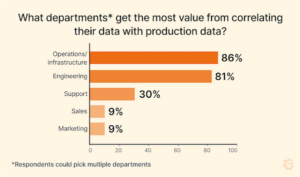
Observability Overload: Grafana Labs Survey Builds a Case for Centralized Solutions

(JOKE_PHATRAPONG/Shutterstock)
Grafana Labs released new survey findings that reveal DevOps and SRE teams are facing an overload of observability tools and data sources, leading them to seek more centralized observability solutions.
“Grafana Labs Observability Survey 2023” showed that 52% of respondents reported using 6 or more observability tools, with 11% saying they use 16 or more, revealing the complexity of the stack of apps and infrastructure in this realm. As for data sources, of the 94% of respondents who named Grafana as their most used observability option, 68% have at least four data sources configured in Grafana. That number gets higher as companies scale up: 41% of companies with 1,000 or more employees pull in 10 or more data sources.
 “As part of the observability report, we did in-depth interviews with tech leads at a handful of our customers to find out more about their specific challenges and the quantifiable impact observability has had on their organizations. One gaming company has achieved a 30-40% decrease in MTTR, and a 10-20% increase in developer productivity, but still struggled to get a holistic view of system health. That’s because each team at the company manages observability on its own, with its own set of disparate tools. That combination of tool sprawl and siloed observability can be a blocker for optimizing observability efforts,” said Julie Dam, head of content and communications at Grafana Labs, in an email interview with Datanami.
“As part of the observability report, we did in-depth interviews with tech leads at a handful of our customers to find out more about their specific challenges and the quantifiable impact observability has had on their organizations. One gaming company has achieved a 30-40% decrease in MTTR, and a 10-20% increase in developer productivity, but still struggled to get a holistic view of system health. That’s because each team at the company manages observability on its own, with its own set of disparate tools. That combination of tool sprawl and siloed observability can be a blocker for optimizing observability efforts,” said Julie Dam, head of content and communications at Grafana Labs, in an email interview with Datanami.
Grafana Labs says it is committed to what it calls a “big tent philosophy,” or the idea that disparate data sources, from different software providers, in various industries, built for all sorts of use cases, can come together in a single composable observability platform. This unified observability has become a solution for stack sprawl according to 70% of those surveyed, with 83% having reported saving time and money when adopting this philosophy.
When asked about the benefits of introducing centralized observability into a stack and cloud infrastructure, one respondent from a software and technology firm reported enjoying a “consistent and delightful developer experience,” along with improved ease of access to metrics, logs, and traces. The respondent also reported faster debugging, improved alerting, and more rapid upgradability to newer versions of the stack.
When it comes to objectives for an observability strategy, different companies have different goals: “Observability is not one size fits all, and neither is ROI. What the survey made very clear is that while saving money was a macro goal, different organizations have different ways to get there. ROI can come in many different forms: MTTx improvements, less toil and infrastructure maintenance, better adoption, a consistent developer experience, less complexity, SLOs, better capacity planning, and better alerting and visibility,” said Dam.
Among all respondents, 37% say they prioritize capacity planning when correlating data, 25% prioritize cost control, and 9% prioritize profitability and margin calculation.
A section of the survey report is devoted to a more detailed examination of the survey respondents, including in-depth interviews. Just for context, Grafana Labs says that the participants were likely predisposed to open source projects and container-based architectures, as 94% use Grafana and 79% use Prometheus, a monitoring platform for cloud-native environments like Kubernetes. Roughly half of the respondents work in the tech sector, and 47% reported being employed at a company with more than 1,000 employees.
Grafana Labs explains that the survey data, combined with the in-depth interviews, reflect a bullish view of observability and reflect an excitement for the continued growth and maturation of this market, with one respondent saying that adoption will pick up as more is invested and refined in these solutions.
“We’re excited to see how far observability has come and how organizations are putting these tools and techniques into practice around the globe and across different industries and organizations of all sizes,” the company said in the report’s conclusion.
Read the full report at this link.
Related Items:
Grafana Labs Adds Two New Projects to Its Observability Stack
How Intelligent Observability Unleashes Innovation
In Search of Data Observability

































